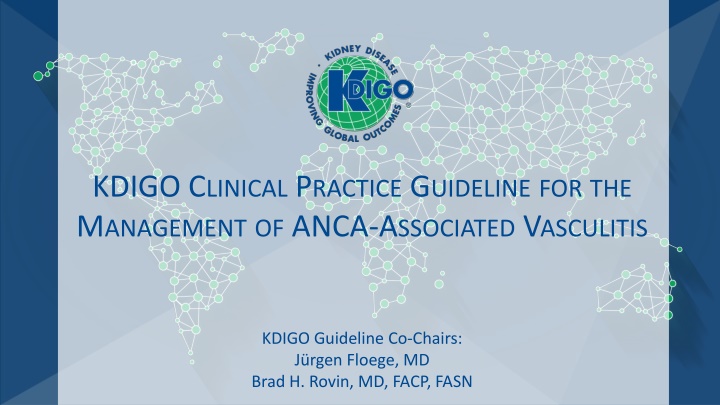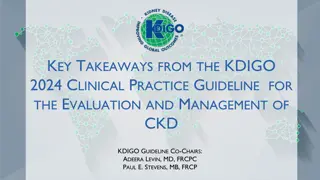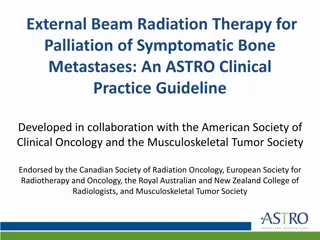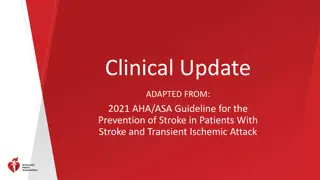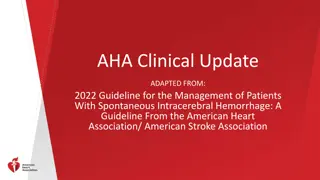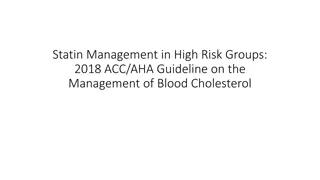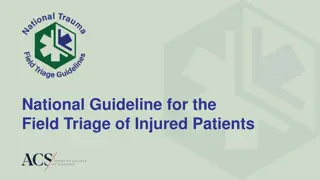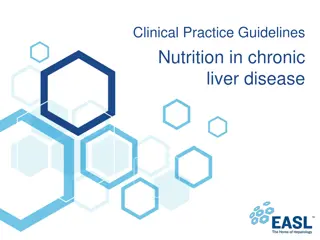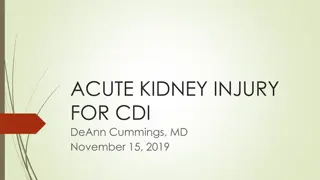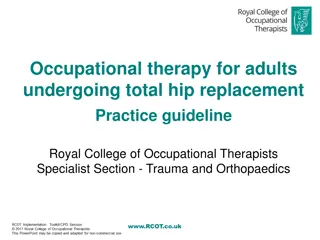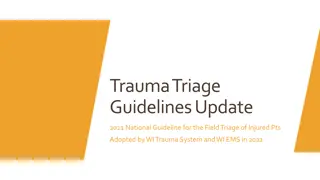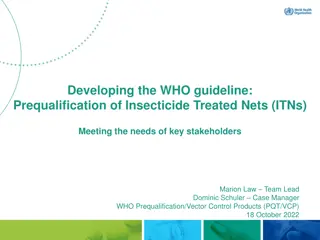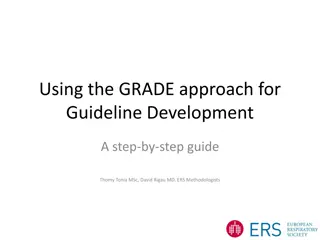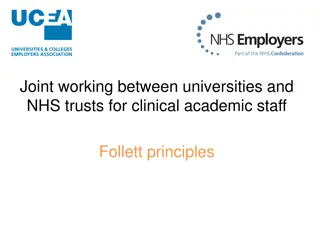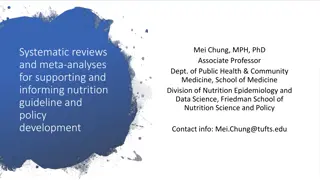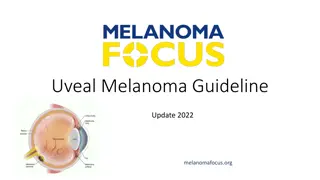KDIGO Clinical Practice Guideline for ANCA-Associated Vasculitis
This guideline provides detailed information on the management of ANCA-associated vasculitis as per the KDIGO 2024 Clinical Practice Guideline. It covers guideline development, key statements, and the rationale behind the recommendations. The guideline emphasizes customization for individual use while maintaining the original verbatim content. Additionally, it outlines KDIGO's programs, controversies conferences, and implementation activities. The initiation of the guideline update following the KDIGO Controversies Conference on Glomerular Diseases in 2017 is highlighted. The document also references previous guidelines from 2012 and 2021, marking an essential update focused on ANCA-associated vasculitis.
Download Presentation

Please find below an Image/Link to download the presentation.
The content on the website is provided AS IS for your information and personal use only. It may not be sold, licensed, or shared on other websites without obtaining consent from the author.If you encounter any issues during the download, it is possible that the publisher has removed the file from their server.
You are allowed to download the files provided on this website for personal or commercial use, subject to the condition that they are used lawfully. All files are the property of their respective owners.
The content on the website is provided AS IS for your information and personal use only. It may not be sold, licensed, or shared on other websites without obtaining consent from the author.
E N D
Presentation Transcript
KDIGO CLINICAL PRACTICE GUIDELINE FOR THE MANAGEMENT OF ANCA-ASSOCIATED VASCULITIS KDIGO Guideline Co-Chairs: J rgen Floege, MD Brad H. Rovin, MD, FACP, FASN
Presenter Note This slide deck covers the information presented in the KDIGO 2024 Clinical Practice Guideline for the Management of Antineutrophil Cytoplasmic Antibody (ANCA) Associated Vasculitis Customization of this deck for your use is encouraged. However, the guideline statements are presented verbatim from the final publication and any edits to these statements is strongly discouraged.
TABLE OF CONTENTS Introduction Guideline development process Guideline statements and rationale from the KDIGO 2024 Clinical Practice Guideline for the Management of Lupus Nephritis Acknowledgements
KDIGO PROGRAMS Guidelines KDIGO s core mission. KDIGO is the only organization developing global guidelines in nephrology. Controversies Conferences International conferences that examine significant topics in nephrology and related disciplines that are not fully resolved. Results in a published paper, usually in Kidney International. Often, a Controversies Conference will prompt development of a guideline or a guideline update. Implementation Activities Dissemination and implementation of KDIGO guidelines Controversies Conference reports and observations Live Clinical Practice conferences usually with a nephrology society to bring global KDIGO s work to local audiences, using case studies Implementation Summits bring local experts together to discuss local or regional barriers and opportunities Core Implementation Kits educational materials including Speaker s Guides, Key Takeaways, Reference Tools, and Case Studies to assist with implementation of all KDIGO publications
KDIGO CONTROVERSIES CONFERENCEON GLOMERULAR DISEASES November 2017 (Singapore) Topics: General principles, Nephrotic syndrome, Membranoproliferative GN (MPGN), C3 glomerulonephritis (C3GN) IgA Nephropathy Membranous GN Minimal change disease (MCD) and Focal Segmental Glomerulosclerosis (FSGS) Lupus nephritis (LN) and ANCA vasculitis Report published in Kidney International (2019) Led to initiation of the update of the KDIGO guideline
KDIGO 2012 GUIDELINE: THE BEGINNING KDIGO 2021 GUIDELINE: THE UPDATE KDIGO 2024 GUIDELINE: THE ANCA UPDATE
TIMELINEOF GUIDELINEFOR MANAGEMENTOF ANCA VASCULITIS
GUIDELINE GOALS Generate a useful resource for clinicians and patients Address relevant questions with actionable recommendations Take on controversial topics when sufficient evidence Communicate clearly Target audience: Primarily clinicians treating patients with ANCA-associated vasculitis Stay true to evidence, where available Propose research questions Be mindful of implications for policy and payment
WHAT IS NEW SINCETHE 2021 KDIGO GUIDELINE The C5a receptor inhibitor, avacopan, has been approved by the United States Food and Drug Administration (FDA) and the European Medicines Agency (EMA) as add-on therapy to standard-of-care for the treatment of ANCA-associated vasculitis (AAV). This development directly relates to the second major emerging novel approach to the treatment of AAV, namely, a reduction of systemic glucocorticoid exposure Identifying the profile of an AAV patient who needs avacopan in order to allow for lower glucocorticoid dosages is less clear. Additionally, this new therapy adds significant cost to treatment, and long-term safety data are currently lacking.
EVIDENCE REVIEW ERT 2021 Guideline: Cochrane Kidney Transplant; 2024 Update: Brown University Existing Population, Intervention, Comparator, Outcome, Study design (PICOS) questions Clinical and important outcomes identified The critical and important outcomes were voted on by the Work Group using an adapted Delphi process (1 9 Likert scale). Critical outcomes were rated 7 9, and important outcomes were rated 4 6 on the 9-point scale. Critical outcomes All-cause mortality Kidney failure 50% loss of GFR Infection Glucocorticoid-related adverse events Malignancy Important outcomes Complete remission or relapse Annual GFR loss (minimum 3 years follow-up) GFR, glomerular filtration rate
PICOS QUESTION Study design Key question Population Intervention Comparator Outcome ANCA-associated vasculitis (AAV) In adults with AAV, what immunosuppressive agents compared to no treatment, placebo, or other immunosuppressive therapies improve clinical efficacy outcomes and reduce adverse effects? Placebo, no treatment, or other immunosuppressive therapy Critical and important outcomes Immunosuppressive therapy Adults with AAV RCTs
LITERATURE SEARCH OCTOBER 2018 SUPPLEMENTED WITHADDITIONALSTUDIESUNTIL SEPTEMBER 2019; UPDATEDIN JUNE 2020, JULY 2022, AND APRIL 2023
EVIDENCE SYNTHESIS Standard Cochrane methods Two independent reviewers Data abstraction Critical appraisal using validated tools Risk of bias graph example Data-analysis Random effects meta-analysis and generic inverse variance Relative risk for dichotomous outcomes Mean difference for continuous outcomes Heterogeneity assessed using the I2 statistic Forest plot example
GRADING RECOMMENDATIONS GRADE methodology The certainty of the evidence Level A, B, C, D Study limitations Inconsistency Indirectness Imprecision Publication bias Strength of the recommendation Level 1, We recommend or Level 2, We suggest Key Information Balance of benefits and harms Certainty of the evidence Patient values and preferences Resources and costs Considerations for implementation Rationale
GUIDELINE FORMAT KDIGO guidelines continue to use the Grading of Recommendations Assessment, Development, Evaluation (GRADE) methodology, but we have strengthened the link between the recommendation statements and underlying evidence base. Guidelines now include a mix of recommendations and practice points to help clinicians better evaluate and implement the guidance from the expert Work Group. All graded recommendations follow a consistent and structured format and are similar in style to previous KDIGO recommendations. Practice points may be formatted as text, a table, a figure, or an algorithm to make them easier to use in clinical practice.
Guideline Statements and Rationale
ANCA-ASSOCIATED VASCULITIS - DIAGNOSIS Practice Point 9.1.1: In the case of a clinical presentation compatible with small-vessel vasculitis in combination with positive myeloperoxidase (MPO)- or proteinase 3 (PR3)- ANCA serology, waiting for a kidney biopsy to be performed or reported should not delay starting immunosuppressive therapy, especially in patients who are rapidly deteriorating.
ANCA-ASSOCIATED VASCULITIS - DIAGNOSIS Practice Point 9.1.2: Patients with ANCA-associated vasculitis (AAV) should be treated at centers with experience in AAV management
ANCA-ASSOCIATED VASCULITIS PROGNOSIS: KIDNEY PROGNOSISAND TREATMENT RESPONSE
ANCA-ASSOCIATED VASCULITIS PROGNOSIS: RELAPSE Practice Point 9.2.3.1: The persistence of ANCA positivity, an increase in ANCA levels, and a change in ANCA from negative to positive are only modestly predictive of future disease relapse and should not be used to guide treatment decisions.
ANCA-ASSOCIATED VASCULITIS TREATMENT: INDUCTION Recommendation 9.3.1.1: We recommend that glucocorticoids in combination with rituximab or cyclophosphamide be used as initial treatment of new-onset AAV (1B).
ANCA-ASSOCIATED VASCULITIS TREATMENT: INDUCTION Practice Point 9.3.1.1: A practical treatment algorithm for AAV with kidney involvement is given in the figure. *Please see Practice Point 9.3.1.9
ANCA-ASSOCIATED VASCULITIS TREATMENT: INDUCTION Practice Point 9.3.1.2: In patients presenting with markedly reduced or rapidly declining glomerular filtration rate (GFR) (serum creatinine [SCr] >4 mg/dl [>354 mmol/l]), there are limited data to support rituximab and glucocorticoids. Both cyclophosphamide and glucocorticoids, and the combination of rituximab and cyclophosphamide can be considered in this setting. Practice Point 9.3.1.3: Considerations for choosing between rituximab and cyclophosphamide for induction therapy are given in the figure below. *A combination of 2 intravenous pulses of cyclophosphamide with rituximab can be considered.
ANCA-ASSOCIATED VASCULITIS TREATMENT: INDUCTION Practice Point 9.3.1.4: Considerations for choosing the route of administration of cyclophosphamide are given in the figure. Practice Point 9.3.1.5: Consider discontinuation of immunosuppressive therapy after 3 months in patients who remain on dialysis and who do not have any extrarenal manifestations of disease.
ANCA-ASSOCIATED VASCULITIS TREATMENT: INDUCTION Practice Point 9.3.1.6: Recommendations for oral glucocorticoid tapering are given in the figure.
ANCA-ASSOCIATED VASCULITIS TREATMENT: INDUCTION Practice Point 9.3.1.7: Avacopan may be used as an alternative to glucocorticoids. Patients with an increased risk of glucocorticoids toxicity are likely to receive the most benefit from avacopan. Patients with lower GFR may benefit from greater GFR recovery Practice Point 9.3.1.8: Recommendations for immunosuppressive dosing are given in the figure.
ANCA-ASSOCIATED VASCULITIS TREATMENT: INDUCTION Practice Point 9.3.1.9: Consider plasma exchange for patients with SCr >3.4 mg/dl (>300 mmol/l), patients requiring dialysis or with rapidly increasing SCr, or patients with diffuse alveolar hemorrhage who have hypoxemia. Practice Point 9.3.1.10: Add plasma exchange for patients with an overlap syndrome of ANCA-associated vasculitis and anti-glomerular basement membrane (GBM)
ANCA-ASSOCIATED VASCULITIS TREATMENT: MAINTENANCE THERAPY Recommendation 9.3.2.1: We recommend maintenance therapy with either rituximab, or azathioprine and low-dose glucocorticoids after induction of remission (1C). Practice Point 9.3.2.1: Following rituximab induction, maintenance immunosuppressive therapy should be given to most patients. Practice Point 9.3.2.2: The optimal duration of remission therapy is between 18 months and 4 years after induction of remission.
ANCA-ASSOCIATED VASCULITIS TREATMENT: MAINTENANCE THERAPY Practice Point 9.3.2.3: When considering withdrawal of maintenance therapy, the risk of relapse should be considered, and patients should be informed of the need for prompt attention if symptoms recur. Practice Point 9.3.2.4: Consider mycophenolate mofetil (MMF) or methotrexate as alternatives to azathioprine for maintenance therapy in patients intolerant of azathioprine. Methotrexate should not be used for patients with a GFR <60 ml/min per 1.73 m2.
ANCA-ASSOCIATED VASCULITIS TREATMENT: MAINTENANCE THERAPY Practice Point 9.3.2.5: Considerations for choosing rituximab or azathioprine for maintenance therapy are presented in the figure.
ANCA-ASSOCIATED VASCULITIS TREATMENT: MAINTENANCE THERAPY Practice Point 9.3.2.6: Recommendations for dosing and duration of maintenance therapy are given in the figure.
ANCA-ASSOCIATED VASCULITIS TREATMENT: RELAPSING DISEASE Practice Point 9.3.3.1: Patients with relapsing disease should be reinduced (Recommendation 9.3.1.1), preferably with rituximab.
ANCA-ASSOCIATED VASCULITIS SPECIAL SITUATIONS: REFRACTORY DISEASE Practice Point 9.4.1.1: Refractory disease can be treated by an increase in glucocorticoids (intravenous or oral), by the addition of rituximab if cyclophosphamide induction had been used previously, or vice versa. Plasma exchange can be considered. Practice Point 9.4.1.2: In the setting of diffuse alveolar bleeding with hypoxemia, plasma exchange can be considered in addition to glucocorticoids with either cyclophosphamide or rituximab.
ANCA-ASSOCIATED VASCULITIS SPECIAL SITUATIONS: TRANSPLANTATION Practice Point 9.4.2.1: Delay transplantation until patients are in complete clinical remission for 6 months. The persistence of ANCA should not delay transplantation.
RESEARCH RECOMMENDATIONS RCTs are needed to incorporate patient-reported outcomes, to assess long-term outcomes, to define the use of rituximab in severe AAV, and to assess therapies in ethnically diverse populations. Biomarker studies to identify early markers of disease relapse, markers to guide the choice of therapy, including plasma exchange, markers to predict optimal dosing and dosing interval for rituximab, and surrogate markers of remission
Acknowledgments KDIGO gratefully acknowledges our Knowledge Translation Lead, Edgar V. Lerma, MD, FACP, FASN, FAHA, FASH, FNLA, FNKF, FASDIN, FCRS, FPSN (Hon) for his time and expertise in creating the speaker's notes in this Speaker's Guide. KDIGO also gratefully acknowledges Guideline Co-Chairs, Brad Rovin, MD (United States), and J rgen Floege, MD (Germany), and the Guideline Work Group for their dedication, time, and insights in authoring the Glomerular Diseases Guideline. This Speaker's Guide was supported by an educational grant from Travere Therapeutics.
Notes Use the subsequent slides to tailor individual presentations
SAMPLE HEADER Bullet 1 Bullet 2 Sub-bullet
